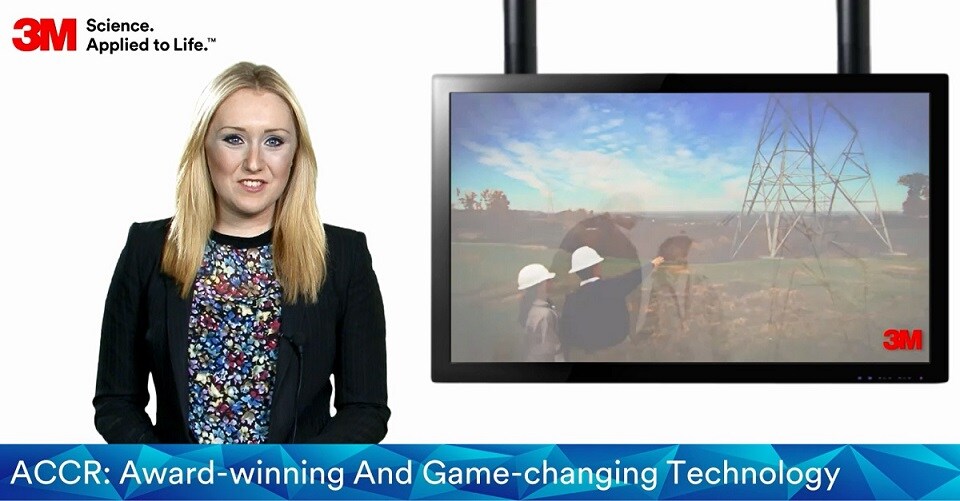-
ACCR Award - Winning And Game - Changing Technology
October 09, 2014 < !-- Tablet Image -->
< !-- Tablet Image --> 
 View Video
View Video-
Today, installations of 3M ACCR help deliver power to millions of consumers and businesses worldwide. It also happens to be a great example of what 3M does well develop innovative technology that deals with real-world challenges. Allan Russell is the 3M Business Development Manager and he explains he’s been lucky enough to be involved in ACCR since it was first commercially launched back in 2004. While it is part of Allan’s daily working life, he never loses sight of the fact that it has been a ‘game-changer’ for power network owners the world over”.
For anyone who is not familiar with ACCR, here is a quick explanation of this incredible innovation and how this translates into benefits for the power network, for consumers and for the environment. Aluminium and steel conductors have long been used in the transmission network and the main incumbent technology, ACSR uses a combination of steel and aluminium. The latter is much lighter than steel, less prone to corrosion, and a far better conductor of energy, but is also mechanically weaker and elongates significantly when heated.
Previous types of conductor suffered from the fact that aluminium can quickly become annealed and lose its strength, thereby affecting the conductor’s mechanical properties and leading to increased sag, which impairs performance and can lead to low line clearance, which is often not acceptable, particularly in urban areas.
More ampacity generates more heat, so before ACCR came along, power network owners were faced with a conundrum: how to increase ampacity without the attendant problems causedby the additional heat that would generate. Then 3M introduced ACCR, which enables capacity to be doubled or more, achieved with significantly less weight than traditional steel conductors and with excellent thermal expansion properties. Moreover, the technology can be deployed as a ‘drop in’ replacement to existing conductors.
3M ACCR was developed with the support of the U.S. Department of Energy, which tested the conductor at its Oak Ridge National Laboratory in Tennessee, and with early contributions by the US’ Defense Advanced Research Projects Agency. The laboratory tests demonstrated that the conductor retains its integrity after exposure to temperatures even higher than the rated continuous operating temperature of 210 degrees Celsius and the emergency operating temperature of 240 degrees Celsius. It has the durability and longevity of traditional steel core conductors, even when operated continuously at high temperatures. ACCR has been recognised in the US by R&D Magazine with an R&D 100 Award as one of the most technologically significant products introduced into the marketplace.
The conductor’s outer wires are composed of hardened aluminium zirconium stranded in either round wire or trapezoidal wire layers, similar to most standard conductors. The core is a multi-strand design, with typically either 7 or 19 wires, with each wire composed of tens of thousands of Alumina fibres in each wire, infused with high purity aluminium. The combination of core and outer wire material and geometry provides a number of advantages. First, the core gives the conductor its strength-to-weight and low thermal expansion, or sag, properties. Second, the aluminium zirconium allows the aluminium to operate at high temperatures without degradation. These properties enable the conductor to carry a substantially increased amount of energy compared to standard conductors.
Power network operators around the world were quick to appreciate the benefits of ACCR, across developed and emerging markets, including existing and greenfield sites. To date, the technology has been used to: dramatically increase power capacity in densely populated areas with minimal building work or disruption; enable line upgrades to happen quickly and with very little impact on the environment; to install power across wide rivers and areas of outstanding natural beauty; to provide consistent power delivery in areas that experience peaks and outages, or extreme weather conditions; and to improve the on-shore outer reaches of networks that are having to transport off-shore power back to the mainland.
For network operators, there are some hard-line commercial benefits too: business models that 3M have carried out regularly demonstrate that ACCR can help to significantly reduce the overall cost of installation projects, including reduced completion time. In Europe, we are witnessing a drive towards ‘future networks’, as part of the need to accommodate increasing power demand in smarter ways, often with the help of renewable energy. With its ability to upgrade existing networks, or build new ones more efficiently and cost-effectively, ACCR can make an important contribution to the future of Europe’s power industry.
-
